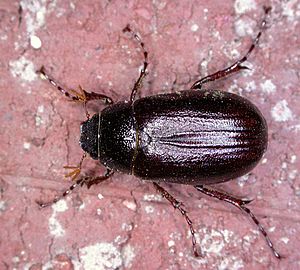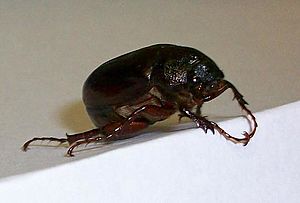Phyllophaga facts for kids
Quick facts for kids Phyllophaga |
|
|---|---|
 |
|
| Phyllophaga | |
 |
|
| Common Phyllophaga found in Michigan | |
| Scientific classification |
|
| Kingdom: | Animalia |
| Phylum: | Arthropoda |
| Class: | Insecta |
| Order: | Coleoptera |
| Family: | Scarabaeidae |
| Tribe: | Melolonthini |
| Genus: | Phyllophaga Harris, 1827 |
| Species | |
|
> 900 |
|
Phyllophaga is a huge group of over 900 types of beetles. They are also known as May beetles, June bugs, or July beetles. These beetles live in the New World, which means North and South America.
They are a kind of scarab beetle. Phyllophaga beetles are usually black or reddish-brown. They can be from about half an inch to one and a half inches long. Many of them have a bit of hair on their underside. These beetles are active at night. You might see them flying around lights in large numbers.
The name Phyllophaga comes from two Greek words. Phyllon means "leaf," and phagos means "eater." So, their name means "leaf-eater," which makes sense because of what they eat!
Contents
Life Cycle of May Beetles
The life cycle of a Phyllophaga beetle usually takes about one year.
Egg Laying and Hatching
In the middle of summer, female beetles lay 60 to 75 eggs. They lay these eggs over about two weeks. The eggs are small and white. They start as oval shapes but become rounder as the baby beetle grows inside. About 18 days after being laid, the eggs hatch.
Grub Stage
When they first hatch, the baby beetles are called larvae or "white grubs." They are about 8 millimeters long. These grubs can grow to be around 40 millimeters long. They are whitish with a brownish-black head. You can see brown spots along their sides called spiracles, which they use to breathe.
The grubs shed their skin twice before winter arrives. The third grub stage lasts for almost nine months. After this long period, they change into a pupa. Grubs often spend the winter underground. They might become active on warm winter days. In the spring, they become much more active.
What May Beetles Eat
Both adult Phyllophaga beetles and their grubs eat plants. They can sometimes cause damage if there are many of them.
Adult Beetle Diet
Adult Phyllophaga beetles are also called chafers. They eat the leaves of trees and shrubs. They also enjoy eating flowers from many different plants. If many adults appear at once, they can cause a lot of damage to plants.
Grub Diet and Damage
The white grubs live in the soil. They feed on the roots of grasses and other plants. This can be a problem in lawns, gardens, and golf courses. If you see patches of grass that are not growing well or turning brown, it might be because of grubs. Birds like crows often dig up grass to find these grubs.
Grubs can also attack vegetables and other garden plants. This includes lettuce, raspberries, strawberries, potatoes, and young ornamental trees. When grubs eat the roots, small plants might suddenly wilt. They might also show slow growth or drop their leaves early. Grubs often move from one plant to the next in a row. They feed underground for three to four years before they turn into adult beetles.
Who Eats May Beetles?
Phyllophaga beetles and their grubs have many natural enemies.
Insect Predators
Some types of flies, like Pyrgotidae flies, chase the adult beetles while they are flying. The fly lays an egg on the beetle's back, under its wing covers. The beetle cannot reach the egg there. When the egg hatches, the fly larva goes inside the beetle's body. It eats the beetle and eventually kills it. Another type of fly, Exoprosopa fasciata, also attacks these beetles. Its larvae feed on the ground and then stay in the grub's cell over winter.
Several kinds of wasps are also parasitoids of Phyllophaga grubs. This means the wasps lay their eggs on or inside the grubs. The wasp larvae then feed on the grubs, eventually killing them.
Animal Predators
Many animals also eat Phyllophaga grubs. This includes different types of amphibians. Some small mammals, like skunks and moles, also enjoy eating the grubs.
See also
 In Spanish: Phyllophaga para niños
In Spanish: Phyllophaga para niños

